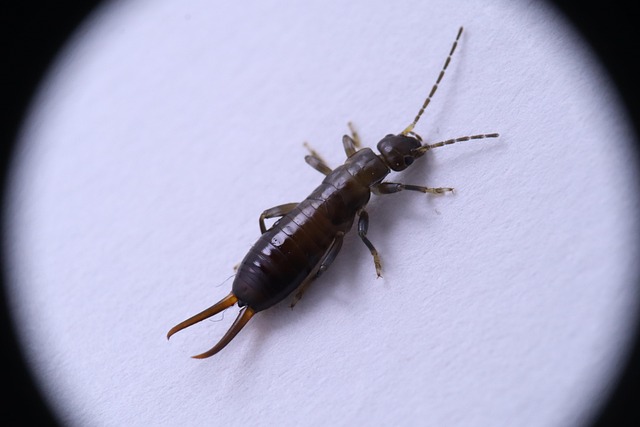Earwigs, though unappealing, pose no direct threat but can cause distress with their peculiar behavior and feeding habits. They enter homes through plants, cracks, gaps, or pipes and feed on organic matter, insects, and each other, damaging plants, clothing, and bedding. Effective residential earwig treatment involves identifying entry points, sealing them, disrupting feeding habits with targeted insecticides, and regular inspections. Recognizing signs like small chewed holes, musty odors, and scurrying earwigs in dark corners is crucial for early detection. Chemical treatments (pyrethroids, neem oil, IGRs) or eco-friendly baits, applied safely under professional guidance, can manage severe infestations, with proper ventilation post-treatment ensuring chemical safety.
Struggling with an earwig invasion in your home? Discover effective chemical treatments for severe residential earwig infestations. Learn how to identify signs of these elusive pests and understand their behavior in your living space. Explore common chemical solutions, from insecticides to baits, to reclaim your environment. We’ll guide you through safe application methods tailored for residential use, ensuring a pest-free haven.
Understanding Earwigs and Their Behavior in Residential Areas
Earwigs are tiny insects known for their distinctive forceps-like appendages, which they use to grasp and manipulate objects—a trait that often leads to their misclassification as “bugs.” Despite their uninviting appearance, earwigs are not harmful to humans. However, their presence in residential areas can be distressing due to their peculiar behavior. Earwigs prefer dark, humid environments and are often attracted to homes by the lush plant life surrounding them. They enter buildings through small cracks, gaps around doors and windows, or even pipes, seeking both shelter and food.
In residential settings, earwigs feed on a variety of organic matter, including decaying plant material, but they also consume other insects and even each other. Their diet makes them a nuisance for homeowners as they can damage plants and even chew through clothing and bedding. Effective residential earwig treatment involves identifying entry points, sealing these gaps with caulk or mesh screens, and using targeted insecticides to disrupt their feeding and nesting habits. Regular inspection and prompt action are key to managing an earwig infestation successfully.
Identifying Signs of a Severe Earwig Infestation
Recognizing the signs of a severe earwig infestation is crucial for effective residential earwig treatment. Keep an eye out for telltale signs like small holes chewed into fabric, paper, or plant matter. Earwigs also leave behind a distinct musty odor, and you might spot them scurrying about in dark corners, crevices, or under furniture.
If you notice any of these indicators, especially in large numbers, it’s a clear indication that an infestation has taken hold. Early detection is key for successful treatment, as earwigs can quickly multiply and spread to other areas of your home if left unchecked. Prompt action ensures a more manageable residential earwig treatment process and minimizes damage caused by these pests.
Common Chemical Treatments for Effective Earwig Control
When it comes to tackling severe earwig infestations, chemical treatments offer effective solutions for both residential and commercial settings. Common chemicals used in earwig control include pyrethroids, neem oil, and insect growth regulators (IGRs). Pyrethroids, derived from natural compounds found in flowers, act as neurotoxins, interfering with the earwigs’ nervous system and causing rapid death. Neem oil, extracted from the neem tree, is a safe and environmentally friendly option that disrupts the insect’s growth and reproduction cycles.
IGRs mimic hormone-like substances, disrupting earwigs’ molting process, which is crucial for their development. These chemicals are particularly useful in preventing future infestations by inhibiting the growth of young earwigs. When applying these treatments, it’s essential to follow label instructions precisely, ensuring safety and effectiveness. Professional pest control services often employ these chemical treatments as part of a comprehensive residential earwig treatment plan.
Safety Precautions and Application Methods for Residential Use
When considering chemical treatments for severe earwig infestations in residential areas, safety precautions are paramount. Earwig control products often contain insecticides that can be harmful if not used properly. Always read and follow label directions meticulously to ensure safe application. Wear protective gear, including gloves, long sleeves, and closed-toe shoes, during treatment to minimize direct contact with chemicals. Keep pets and children away from treated areas until the product has fully dried. Ventilate the space by opening windows and doors to reduce chemical buildup in the air.
Application methods for residential earwig treatments vary depending on the product chosen. Common strategies include spraying, dusting, or using baits. Spraying insecticides directly onto visible earwig habitats and entry points can be effective but requires careful targeting to avoid non-target organisms. Dusting powdery formulations into cracks, crevices, and hard-to-reach areas where earworms hide is another method, ensuring direct contact with the insects. Using earwig baits involves placing attractive substances treated with insecticides in strategic locations to lure and eliminate the pests. This approach is considered more eco-friendly as it targets only the intended species.
In addressing severe earwig infestations in residential areas, understanding these insects’ behavior and employing effective chemical treatments are key. By identifying signs of an infestation early and utilizing appropriate safety precautions during application, homeowners can successfully manage earwigs using methods tailored for their local settings. Choosing the right chemical treatment, combined with good pest management practices, ensures a comfortable and bug-free home environment. For effective residential earwig treatment, consulting professionals and following recommended protocols are essential steps towards a peaceful living space.
